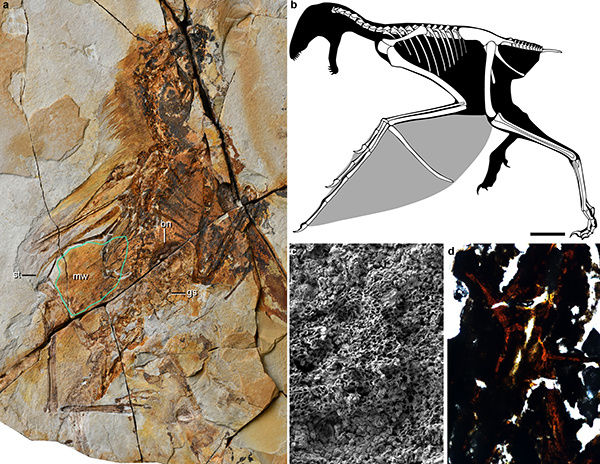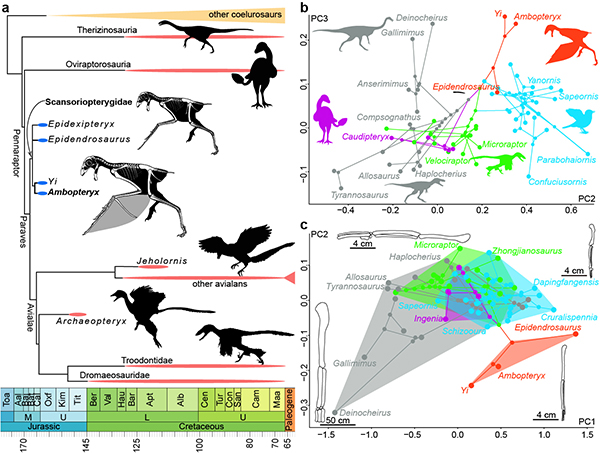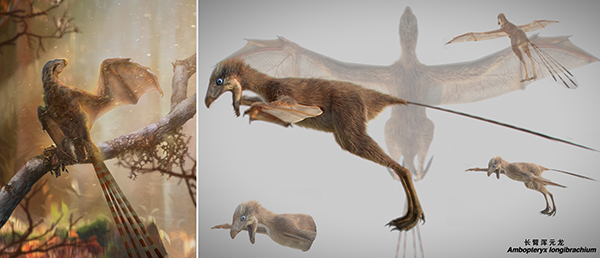| Location: Home > Research > Research Progress |
| New Jurassic Non-avian Theropod Dinosaur Sheds Light on Origin of Flight in Dinosauria |
|
A new Jurassic non-avian theropod dinosaur from 163 million-year-old fossil deposits in northeastern China provides new information regarding the incredible richness of evolutionary experimentation that characterized the origin of flight in the Dinosauria. Published in Nature, Drs. Min Wang, Jingmai K. O’Connor, Xing Xu, and Zhonghe Zhou of the Institute of Vertebrate Paleontology and Paleoanthropology of the Chinese Academy of Sciences in Beijing describe and analyze the well-preserved skeleton of a new species of Jurassic scansoriopterygid dinosaur with associated feathers and membranous tissues. The new species, named Ambopteryx longibrachium, belongs to the enigmatic clade the Scansoriopterygidae, one of the most bizarre groups of non-avian theropods. The Scansoriopterygidae differ from other theropods in the proportions of their body plan, particularly in the proportions of the forelimb which supports a bizarre wing structure first recognized in a close relative of Ambopteryx, Yi qi. Unlike other flying dinosaurs, namely birds, these two species have membranous wings supported by a rod-like wrist bone (termed the styliform element) that is not found in any other dinosaur (but is present in pterosaurs and flying squirrels). Until the discovery of Yi qi in 2015, such a flight apparatus was completely unknown among theropod dinosaurs – and its discovery in Yi qi was completely unexpected. Due to incomplete preservation in the holotype and only known specimen of Yi qi, the veracity of these structures and their exact function remained hotly debated. As the most completely preserved scansoriopterygid specimen to date, Ambopteryx preserves membranous wings and the styliform element, supporting the widespread existence of these wing structures in the Scansoriopterygidae. Using a phylogenetic principal components analysis, Dr. Wang and his colleagues investigated the eco-morphospace disparity of Ambopteryx relative to other non-avian coelurosaurians and Mesozoic birds. The results of this analysis capture dramatic changes in wing architecture that evolved near the split between the Scansoriopterygidae and the avian lineage, as the two clades diverged and underwent very different evolutionary paths to achieving flight. Interestingly, forelimb elongation, an important characteristic of volant dinosaurs, was achieved in scansoriopterygids primarily through elongation of the humerus and ulna, whereas the metacarpals were elongated in non-scansoriopterygid pennaraptorans including Microraptor and birds. In scansoriopterygids the presence of an elongate manual digit III and the styliform element probably compensated for the relatively short metacarpals and provided the main support for the membranous wings (notably, in the first discovered scansoriopterygid, the juvenile holotype of Epidendrosaurus, which preserves neither the styliform process nor traces of any soft tissue, the elongate third manual digit was hypothesized to be a feeding adaptation similar to the extant aye-aye). In contrast, selection for relatively elongate metacarpals in most paravians was likely driven by the need for increased area for the attachment of the primary remiges, which create the wing surface in Microraptor and birds (two other independent origins of flight in the Dinosauria). The co-occurrence of short metacarpals with membranous wings, versus long metacarpals and feathered wings, exhibits how the evolution of these two significantly different flight strategies affected the overall forelimb structure. So far, all known scansoriopterygids are from the Late Jurassic – this unique membranous wing structure did not survive into the Cretaceous. This suggests that this wing structure represents a short-lived and unsuccessful experimentation with volant behaviour. In contrast, feathered wings, first documented in Late Jurassic non-avian theropods (e.g., Anchiornis), were further refined through the evolution of numerous skeletal and soft tissue modifications, giving rise to at least two additional independent origins of dinosaur flight (Microraptor and birds) and ultimately leading to the current success of modern birds, the most diverse clade of land vertebrates on the planet. So, where should you look if you really want to find some fantastic beasts? Maybe in the rocks beneath our feet.
Figure 1. A membranous-winged 163-million-year old non-avian theropod, Ambopteryx longibrachium, from China. a. Fossil; b. restoration, scale bar equal 10 mm; c. melanosomes of the membranous wing (mw); d. histology of the bony stomach content (bn). st, styliform element; gs, gastroliths. Credit: Min Wang
Figure 2. Cladogram and phylomorphospace of Mesozoic coelurosaurians. Credit: Min Wang
Figure 3. Life reconstruction of the bizarre membranous-winged Ambopteryx longibrachium (artwork by Chung-Tat Cheung). |


